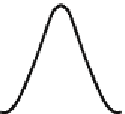Geoscience Reference
In-Depth Information
2
2
c
c
c
c
D
D
v
R
c
(14.1a)
L
T
2
2
x
t
x
y
1 is the retardation factor which expresses the 'loss' of solute due to
absorption at or in the solids of the porous matrix, and
Here,
R
B
is an autonomous decay
factor, expressing that the solute vanishes according to exp(
t/R
). For a constant
groundwater discharge, equation (14.1a) can be reformulated into
:
2
2
7
C
C
C
8
9
5
6
D
L
(14.1b)
2
2
;
with
C
=
c
e
,
2
=
D
L
/
D
T
;
= x
v
,
=
)
y
,
= t
/
R
,
)
The solution for a point injection of intensity
A
becomes
2
2
A
;
C
(
;
,
,
)
exp(
)
(14.2)
4
4
D
L
The maximum concentration is found at (
;
,
) = (0,0), equal to
A
/(4
). Because
at the location of the maximum
x
=
v
holds,
C
max
=
Av
/(4
x
). Inserting
C = c
exp
t
,
leads then to
c
max
=
Av
e
x
/v
/(4
x
). The spreading due to dispersion is expressed by
)
0.5
and
)
0.5
. The trend of decay and
the standard deviation
L
= (2
D
L
T
= (2
D
T
spreading is shown in Fig 14.5.
t = 0
t = 100
t = 200
t = 300
c
(:) e
-x/v
/x
2
L
2
L
2
L
x
Figure 14.5 The decay and delay of a point injection in a 2D uniform flow
Adsorption and desorption
The amount of adsorbed matter (adsorbate) depends on the concentration
(adsorbens). Several formulas describe this behaviour (Freunlich, Langmuir). The
process is usually temperature dependent. For electrolytes other aspects have to be
accounted for as well. In general one can state that all aromatic matter is strongly









































Search WWH ::

Custom Search